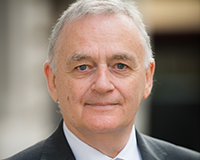 Property analyst Mike Prew of US investment bank Jefferies turned into a big growly bear on Monday. That very day the FTSE 100 index took a mauling, tumbling 288 points to 5,898, as investors ran into the woods.
Property analyst Mike Prew of US investment bank Jefferies turned into a big growly bear on Monday. That very day the FTSE 100 index took a mauling, tumbling 288 points to 5,898, as investors ran into the woods.
Faultless timing from Prew, whose message is clear: values will stall in the first half of 2016 and start to fall in the second half. Even so, a translation of the “key takeaway” paragraph from his 83-page note might be of some service for those wondering why he thinks the downturn is coming. Don’t worry if you find your lips moving. Perfectly understandable.
The note is headlined “Punctuated equilibrium”. It begins: “We expect commercial property values to deflate in 2016 with rising cap rates and patchy rental growth driven by retail, so REIT shares will de-rate.
“The bear case is compounded by proposals to limit the tax shield on debt to 30% of EBITDA. It is a WIP with the OECD/G20, but REITs may potentially have to pay out higher mandatory dividends, possibly more than they earn. Our ‘BUYs’ are repealed and BLND, HMSO, INTU, UTG & CAPC downgraded to U/P & PTs -12%.”
Decoding “WIP with the OECD/G20” needed an Enigma machine. Explanation later. Meanwhile, what’s punctuated equilibrium? Well, Prew feels “trade is in equilibrium but that is set to be ‘punctuated’” because “cap rates [read yields] are now overvalued by 30 basis points [read 0.3%]”. Honestly still not sure what punctuated means. Punctured? Never mind, the last sentence is fairly clear. Jefferies has cut share price targets (PTs) of the following by an average of 12%: British Land, Hammerson, intu (obviously) Unite and Capital & Counties.
But not Land Securities. This is in part because Rob Noel’s empire has to keep interest costs a shade under 30% of its EBITDA (basic profits). As the note says, there are “proposals to limit the tax shield”. This work in progress (WIP) comes from the OECD. They will be tabled at the G20 summit in Lima on 8 October. So, the prospect of implementation may be some way off.
Even so, begin to imagine the squeeze if EBITDA falls and interest rates rise. Note: debt costs as a proportion of profit of those downgraded by Prew are 40% and above, with Unite at more than 50%.
Joe Valente, head of research at JP Morgan Asset Management, was the first big bear into the woods, with gloomy messages printed here on 20 June and 15 August. Valente, 58, called the top of the last cycle in 2006. Prew, 50, called the top in 2007 and the bottom in 2009.
No growling as yet from younger analysts, sideswiped by Prew in his note as “unencumbered by experience”. Prew’s experience shows when he departs from financial analysis and prints a subjective list of 25 “things that keep us up at night”.
Here are just three: “Sunday Times (24 May) article ‘Up, up and away’ predicts a 15-year super-cycle”; “The last time REITs were this good they needed rights issues nine months later”. “In Nine Elms 112 flats worth £190m are for sale before they have been built”. Chosen by me, because it leads neatly on to…
Wondering heights
Question one: how much extra will it cost to fortify the foundations and frame of two 10-storey blocks of flats in Nine Elms, SW8, in order to take the static and dynamic forces imposed by a transparent glass swimming pool weighing at least 320 tonnes? The 25m by 5m by 1.2m deep “sky pool” will bridge the two structures at roof level, 35m up in the air, according to details released by developer Ballymore last week.
Question two: how much will the open-air pool cost to build?
Question three: will the extra-over returns from the flats beneath justify the extra-over costs of the pool?
Question four: is this just a PR stunt to stimulate sales? Not according to Ballymore boss Sean Mulryan, who says: “My vision for the sky pool stemmed from a desire to push the boundaries in the capability of construction and engineering.”










